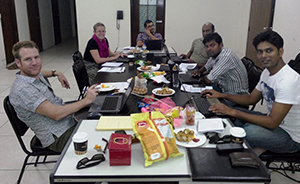In August 2014 heavy rains in the main river basins in Bangladesh, and upstream catchments of India, led to severe flooding in the north-west region of the country.
Australian volunteers Jennifer Burley – who works for SOLIDARITÉS INTERNATIONAL – and Liam Costello were part of a core team that coordinated the flooding Joint Needs Assessment (JNA) supported by DFID and ECHO; helping the humanitarian community understand the nature and impact of the disaster and establishing a foundation of information from which humanitarian agencies could respond. The ultimate aim was to increase the effectiveness of humanitarian aid through a more coordinated response effort.
In Bangladesh floods are both a natural and regular phenomenon. In any given year, one fifth to a third of the country will be affected. The nation relies on this annual inundation to support low land paddy field cultivation and feed its 150 million plus inhabitants. Yet floods present a dichotomy of bounty and destruction. The extreme floods of 2007 affected approximately 68% of the country [1]. In a disaster context, they are difficult events to predict and measure.
In 2014, floods have again caused significant impact to low-lying regions of Bangladesh. In late August the government reported 160,000 people affected by floods and living in deteriorating conditions. More rain was forecast and there was potential for up-stream dam releases across the border in India. Following initial emergency relief from government and some non-government organisations (NGOs), a more coordinated, cross-sector assessment of the floods’ impact was requested by the country’s disaster response actors.
Better coordination for more effective aid

In Bangladesh, government and NGOs convene under the United Nations Humanitarian Coordination Task Team (HCTT), which sits with the Department of Disaster Management to encourage joint interventions that meet common objectives, while also increasing aid effectiveness through a more coordinated response effort.
In response to the floods, the HCTT triggered a Joint Needs Assessment (JNA) in nine districts: an initial assessment of numbers of people affected and the relative accessibility of food, water, sanitation, markets, education and health facilities. A JNA relies on strong interagency collaboration and voluntary in-kind contributions – this assessment mobilised 183 staff from 28 organisations to visit 300 locations in four days. Assessment teams in the field returned data forms to the team in Dhaka who worked over the weekend to establish the scale of the disaster, the worst affected areas and the immediate and ongoing needs. A 50 page draft report was circulated within four days of the data being received.
Analysis : towards a clearer picture
 Jennifer Burley, who is currently on assignment as a Disaster Risk Reduction and Climate Change Officer with SOLIDARITÉS INTERNATIONAL, played a lead role in writing the report. This included compiling significant background information from government and NGO reports. The experience provided Jenny with an opportunity to analyse and develop cross-sector findings and recommendations, and insight into the complex inner workings of the humanitarian coordination system.
Jennifer Burley, who is currently on assignment as a Disaster Risk Reduction and Climate Change Officer with SOLIDARITÉS INTERNATIONAL, played a lead role in writing the report. This included compiling significant background information from government and NGO reports. The experience provided Jenny with an opportunity to analyse and develop cross-sector findings and recommendations, and insight into the complex inner workings of the humanitarian coordination system.
As the Information Management Officer for the Bangladesh Food Security Cluster, Liam Costello managed the data processing and analysis for the assessment and presented the JNA findings to a meeting of United Nations agency heads, donor representatives, international NGOs, and government stakeholders. The numbers found through the report were staggering: 1.8 million affected; 230,000 displaced; restricted access to health facilities and schools; damaged latrines affecting the water supply in some areas; and several markets inaccessible or not functional.
It’s easy to be alarmed by the scale of impact resulting from disasters in Bangladesh. However for long-term observers and locals it appears easy to become complacent given the frequency of these types of events. The coping strategies for many of those affected are well rehearsed, and in small to moderate flood events, communities know when and where to evacuate to. People may populate areas knowing the high probability of periodic flooding and choose to sacrifice their indemnity in favour of proximity to water and fertile soil – so what of their displacement if it was expected?
Assessments : an essential element of disaster response
The relative significance of this year’s floods has yet to be established. They have certainly not reached the scale of the five major floods since 1987 – each inundating up to 60% of the country and damage bills in the order of one to six billion dollars. The sobering reality is that a disaster of this scale is likely to happen again in five or 10 years. It is uncommon for Bangladesh to make it through a year without having some people affected by flood. With two thirds of Bangladesh’s land less than 10m above sea level, an increasingly unpredictable climate and a network of often unreliable infrastructure, flooding is an ever present element of Bangladesh’s annual cycle. The population density means human impact is almost assured.
Nevertheless Bangladesh’s flood preparedness is increasing through improved forecasting and warning systems, more sophisticated housing designs, improved agricultural and land-use decisions and development of social capital and economic capacity. As the fifth most disaster prone country in the world, emergency relief efforts and the assessments that inform them remain an essential element of flood management.
This article, co-authored by Jennifer Burley and Liam Costello, was first published on volunteering.scopeglobal.com.
Access the JNA report in full.
Find out more about our approach to disaster risk reduction.
Bangladesh
Context and action- 165.65 million inhabitants
- 129th out of 191 countries on the Human Development Index
- 29.780 people helped

